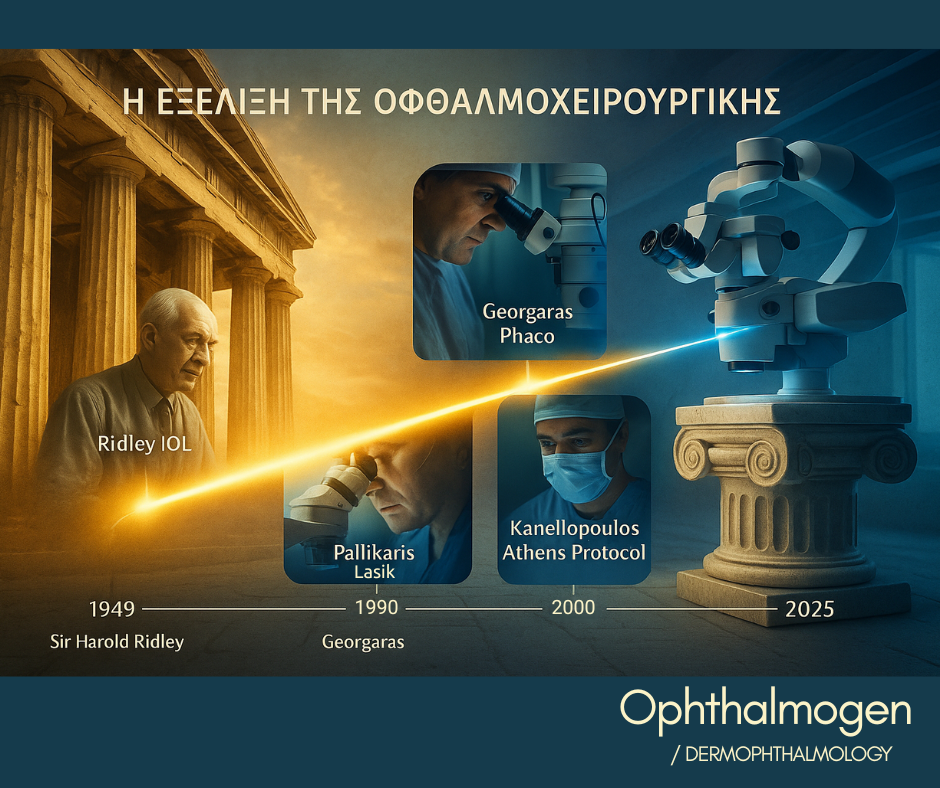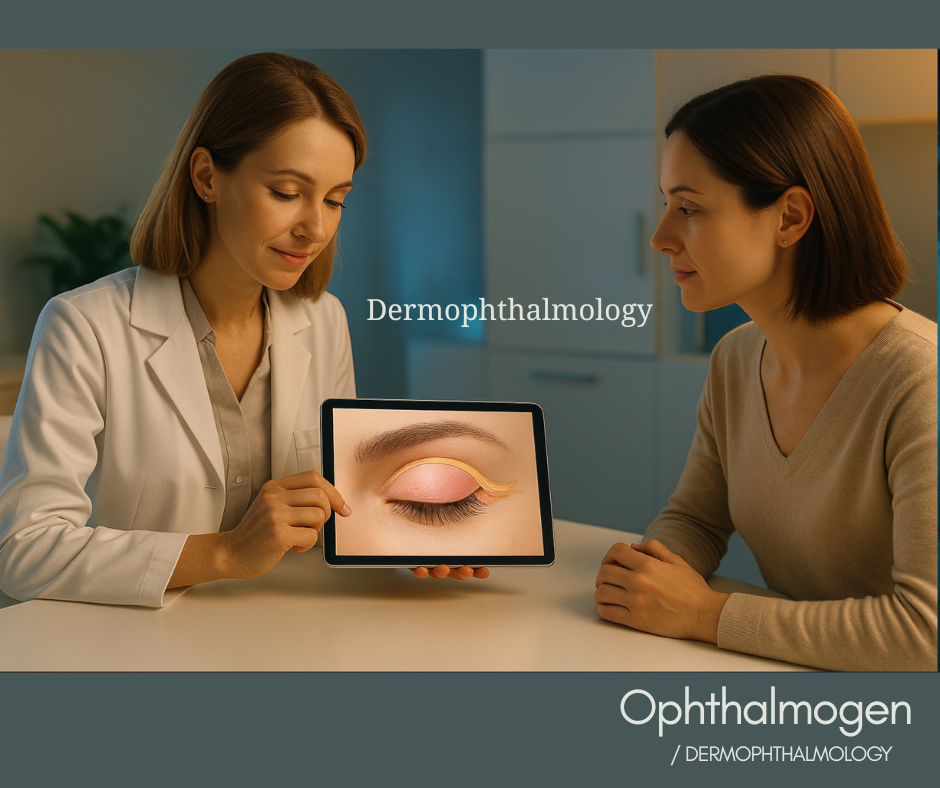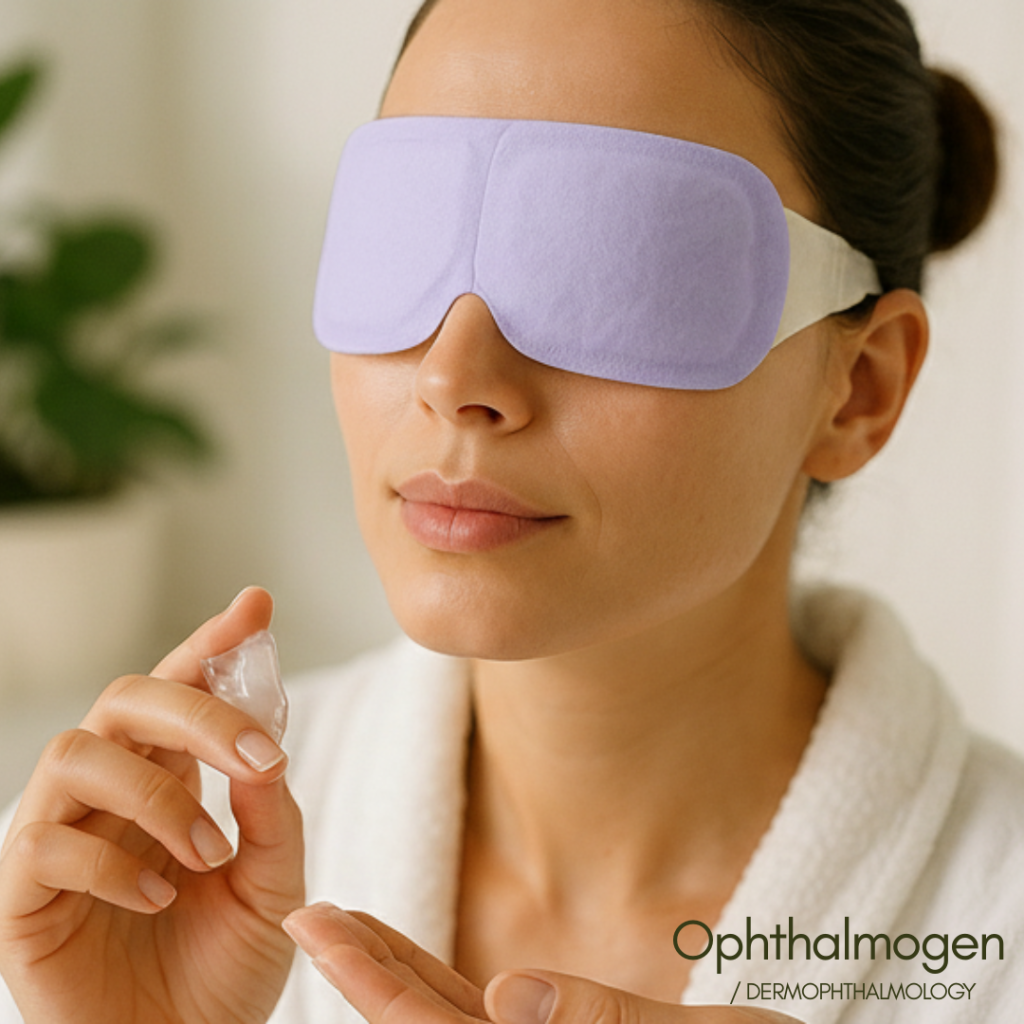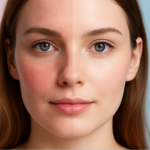
Introduction – The Big Picture
Vision is our most precious sense. 80% of the information we receive from the world comes through our eyes. Our daily life, work, safety, and social interactions depend on it. It is no coincidence that most people say their greatest fear is losing their sight.
The progress of ophthalmic surgery over the past 70 years has been extraordinary. Procedures such as:
- Phacoemulsification for cataract,
- LASIK and refractive techniques,
- Lens implants (ICL, multifocal, toric),
- Corneal transplants,
Corneal transplants, have given millions of people the chance to see clearly again, gain independence from glasses and contact lenses, and dramatically improve their quality of life.
And yet, there is a paradox. We invest in top technology, we trust highly skilled surgeons, but we often neglect the most basic element: the care of the ocular surface and eyelids.
The result?
Many patients, after surgery, develop frustrating symptoms: tearing, redness, dry eye, allergic reactions, discomfort. Not because the surgery failed, but because the eyes were not properly prepared.
This is where hygiene comes in. Just as we brush our teeth every day, our eyes also need cleansing, hydration, massage, and microbial control. This simple but overlooked step can make the difference between a good and an excellent surgical outcome.
Hygiene is the “hidden” 50% of success.
Historical & Scientific Framework
Ophthalmology is a field where both international and Greek pioneers have left an indelible mark.
SirHaroldRidley – The Father of the Intraocular Lens
In 1949, British surgeon Sir Harold Ridley introduced the first intraocular lens (IOL), inspired by his observations of WWII pilots who had acrylic fragments in their eyes without causing rejection.
Ridley’s idea laid the foundation for modern cataract surgery.
Spyros Georgaras – The Greek Pioneer of Phacoemulsification
Professor Spyros Georgaras played a decisive role in the spread and establishment of phacoemulsification in Greece and Europe. Through his academic and clinical work, he trained generations of ophthalmologists from Greece and all over the world, helping transition from older, more traumatic cataract removal methods to a minimally invasive and safe technique. His contribution is a reference point for both Greek and international ophthalmology.
Ioannis Pallikaris – The Father of LASIK
In the 1990s, Professor IoannisPallikaris from the University of Crete introduced LASIK (Laser in Situ Keratomileusis). His innovation radically changed the way we treat myopia, hyperopia, and astigmatism.
Thanks to Pallikaris, millions of people worldwide gained clear vision without glasses or contact lenses.
Epidemiological Data – The “Silent Pandemic”


Despite progress, ocular surface diseases undermine surgical outcomes:
- Cataract: 70–80% of candidates already have dry eye or blepharitis before surgery.
- LASIK: 95% of patients experience dry eye immediately after surgery, worsened by blepharitis.
- IOLs: 40–50% report reduced satisfaction due to unstable tear film.
- Corneal transplant: neglect of hygiene significantly increases infection and rejection risk.
Conclusion
The issue is not the surgical technique but the condition of the ocular surface on which surgery “sits.”
Dermophthalmology – The New Answer
Dermophthalmology, the new field combining dermatology and ophthalmology, fills this gap.
- It treats the eyelid, eyelashes, meibomian glands, and tear film as a single functional unit.
- It applies dermatological principles to the eyes: cleansing, microbial/parasitic control, hydration, prevention.
- It ensures every surgery starts from a “clean and healthy field.”
Surgeries & The Role of Hygiene
Cataract – The Most Common Surgery in the World
Cataract surgery is the most common surgical procedure worldwide, with millions of cases annually.Yet, behind this “miracle” lies a hidden truth: 70–80% of candidates already have dry eye or blepharitis.
Why do symptoms appear after surgery?
Because postoperative drops (steroids/antibiotics) temporarily suppress inflammation. Once discontinued, underlying problems surface—often ignored for decades.
Proper hygiene before and after surgery ensures success:
- cleansing with Ophthalmogen & Naviblef,
- Ophthalmogen Spray to control Demodex,
- Ophthalmogen Gel massage for microcirculation,
- OphthalmogenEYE10 thermotherapy to unblock glands,
- Artificial tears for hydration.
LASIK – The Greek Scientific Revolution
LASIK, thanks to Pallikaris, revolutionized ophthalmology.However, 95% of patients experience some degree of dry eye post-op.
Without hygiene:
- blurred vision,
- burning sensation,
- discomfort at screens.
With hygiene:
- stabilized tear film,
- reduced dry eye,
- better and faster patient satisfaction.
Lens Implants – Enthusiasm and Pitfalls
Multifocal and toric lenses promise independence from glasses. But satisfaction doesn’t depend only on the lens—it depends on the clarity of the window through which it works.
Studies show 40–50% of multifocal lens patients report reduced satisfaction due to dry eye.
Hygiene dramatically improves the experience:
- stable tear film,
- less dry eye,
- clearer, more comfortable vision.
Corneal Transplant – The Gift and the Responsibility
Corneal transplantation restores sight to patients with keratoconus, trauma, or severe dystrophies.But success depends not only on surgery and immunosuppressive drops—it depends on eyelid hygiene.
- Eyelids host bacteria, sebum, and parasites like Demodex.
- Without hygiene, these threaten the graft with infection.
Hygiene is the invisible safety net, as critical as medication, in protecting the graft.
The Aesthetic & Psychological Dimension
Aesthetic consequences of blepharitis
- Dark circles: often linked not only to sleep deprivation but to inflammation, microcirculation issues, and dry eye.
- Ptosis (drooping eyelids): chronic inflammation can weigh down eyelids, making eyes look tired.
- Eyelash thinning/loss: blepharitis and Demodex cause lash loss or misdirected growth.
- Redness and itchiness: give the eyes a “sickly” appearance.
These aesthetic issues impact self-confidence, mood, and even professional or social interactions.


The Dermophthalmology Approach – The “Hidden” 50%
- Καθαρισμός με Ophthalmogen & Naviblef
- Ophthalmogen Spray
- Massage with Ophthalmogen Gel
- Ophthalmogen EYE10 Thermotherapy with self-heating eye compresses
- Artificial tears & Omega-3 (Allvita Eyes)
What brushing your teeth is to your eyes, hygiene is to your eyes.
Case Studies
- Cataract – John, 68: After surgery, constant tearing. Cause: neglected blepharitis. Solution: daily hygiene. Vision clear again.
- LASIK – Maria, 34: Severe dry eye post-op due to pre-existing blepharitis. With thermotherapy and gel massage, symptoms resolved.
- Lens Implants – Andrew, 56: Multifocal lenses seemed disappointing. Cause: MGD. With spray and lid care, clarity restored.
- Corneal Transplant – George, 52: Repeated inflammations threatened graft. With hygiene + Ophthalmogen Spray, graft stabilized.
FAQ
- Why do my eyes water after surgery?
- Can blepharitis affect LASIK results?
- If I don’t see clearly after lens implantation, is it the lens’ fault?
- Aren’t medications after transplant enough?
- When should I start lid hygiene?
Conclusion
Eye surgeries are a triumph of medicine. From cataract and LASIK to lens implants and corneal transplants, they restore the gift of sight to millions. But surgery is only half the story. The other half is daily hygiene. Without it: dry eye, redness, tearing, dissatisfaction. With it: clear vision, comfort, youthful eyes, quality of life. Dermophthalmology shows us that medicine and aesthetics are not opposites. Health and beauty go hand in hand. Surgery gives the “gift.” Hygiene makes it lasting, comfortable, and beautiful.
Discover the full Ophthalmogen range at www.ophthalmogen.com and Dermophthalmology at www.Dermophthalmology.com
Give your eyes the care and beauty they deserve.






